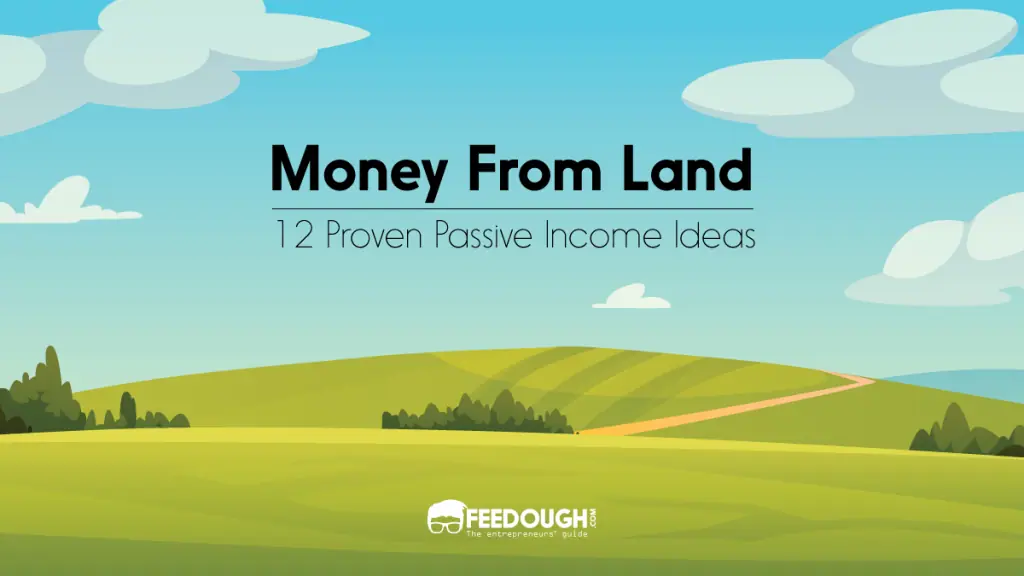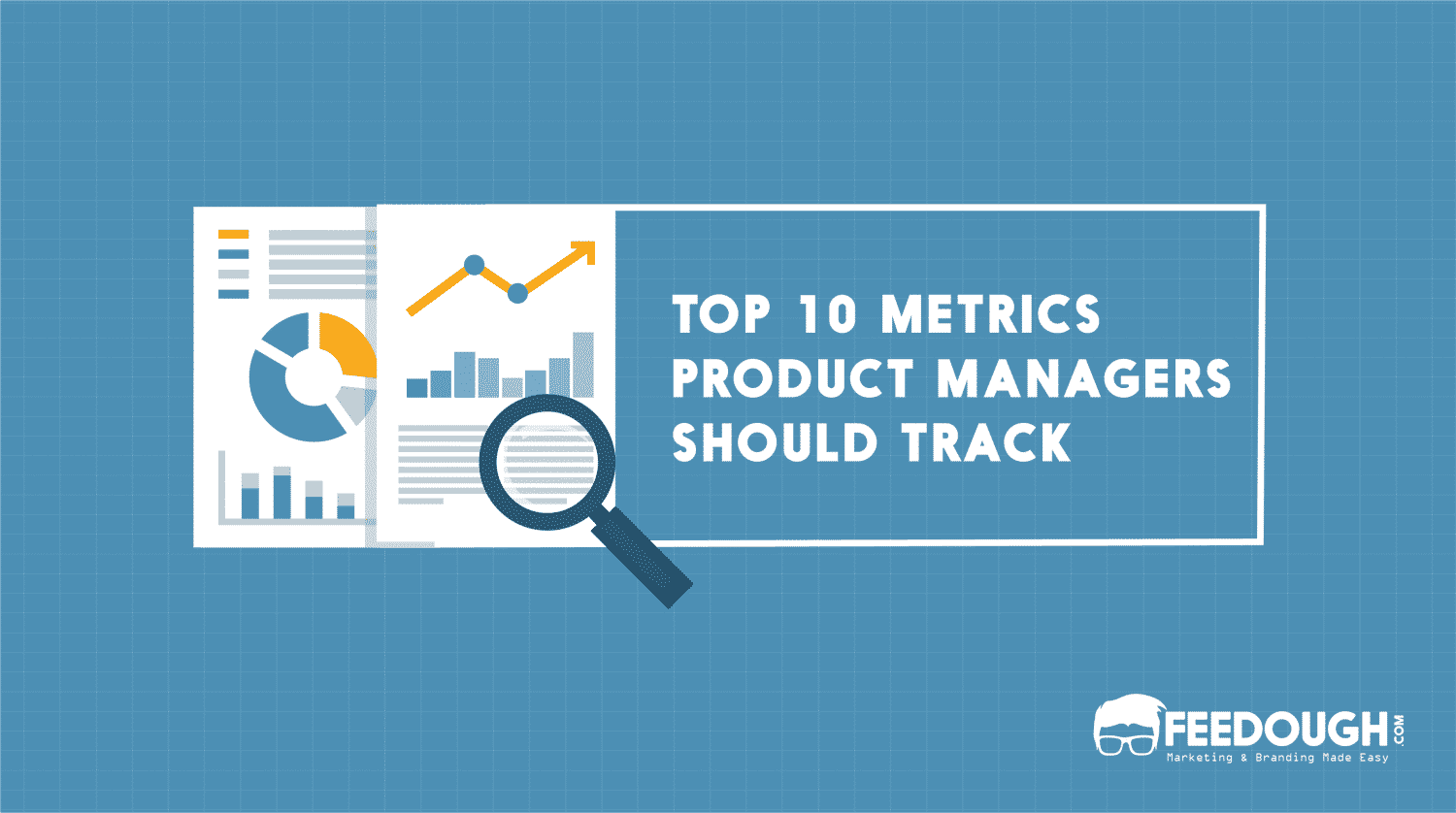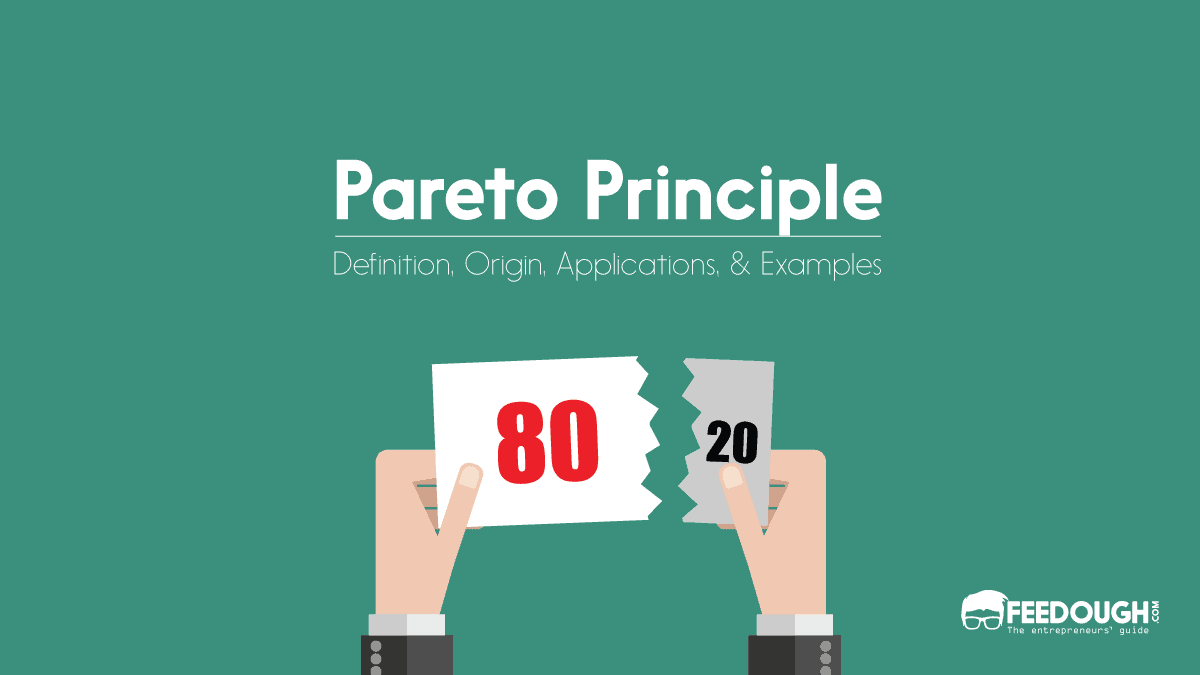Research shows the average US land cost is around $12,000 per acre.
Wouldn’t it be great if your land could start chipping in on that price tag?
When people buy land, their first thought is to build a house there. Well, we get it.
But before you call in the bulldozers and start laying foundations, let’s pause.
Untapped potentials are lying in your land, and with a little creativity, you could unlock a wealth of opportunities.
Let’s uncover 12 passive income ideas that will help you generate passive income from your land and will show how your vacant land can begin to pay dividends.
Money From Billboard Advertising

If your land is beside a busy highway, leasing it out for billboards can be a lucrative source of passive income.
This type of outdoor advertising allows you to lease a portion of your land to place a billboard. Companies then use this billboard to display their brands, products, or services.
Positioned along busy roads, highways, or urban centres, billboard advertising offers you a continuous revenue stream with minimal effort on your part.
The operational model is simple and requires little maintenance. Your active involvement is minimal after securing permits, possibly constructing the billboard structure, and signing a lease agreement with an advertiser or advertising company.
The company renting the space maintains the billboard, updates the advertisements, and makes any necessary repairs, further reducing your workload.
How Can You Make Money From Billboard Advertising?
- Market Analysis: Research which areas need better cellular service. Telecom companies target locations based on network coverage gaps.
- Outreach: Directly contact mobile network operators or companies specialising in telecommunications infrastructure. They can assess your property’s suitability for their needs.
- Negotiation of Terms: Cell tower leases can be highly lucrative but require specific negotiations on lease rates, duration (often 20-30 years), and terms of equipment maintenance and upgrades.
- Permit and Construction: Work with the lessee to obtain any required permits from local authorities. Be prepared for a construction phase involving heavy equipment.
- Ongoing Partnership: Maintaining a good relationship with the lessee ensures your passive income stream stability. Be sure to establish clear communication channels and regular check-ins.
How Much Can You Earn From Billboard Advertising?
The income from billboard advertising can vary greatly depending on several factors like:
- Location: Billboards in high-traffic areas, cities, or along busy highways will command higher fees than those in less travelled areas.
- Visibility and Traffic: The more people see the billboard, the more valuable it is. Advertisers pay more for highly visible billboards that are exposed to a lot of traffic.
- Size and Type: Larger billboards or digital displays generate higher income than smaller or static ones.
- Demand: If there’s a high demand for advertising space in the area, you can charge more for your billboard space.
- Local Regulations: City or regional advertising regulations can affect the availability and desirability of billboard space.
Given these factors, here’s a rough estimate of potential earnings:
- Rural Areas: Between $250 to $2,000 per month.
- Suburban Areas: Between $1,500 to $3,000 per month.
- Urban Areas: Between $2,000 to $15,000 per month or more, especially in high-density regions or downtown areas of major cities.
Digital billboards, which can display multiple advertisements, could earn even higher—potentially upwards of $20,000 to $30,000 per month in the most coveted locations.
Leasing Land To Solar Power Companies
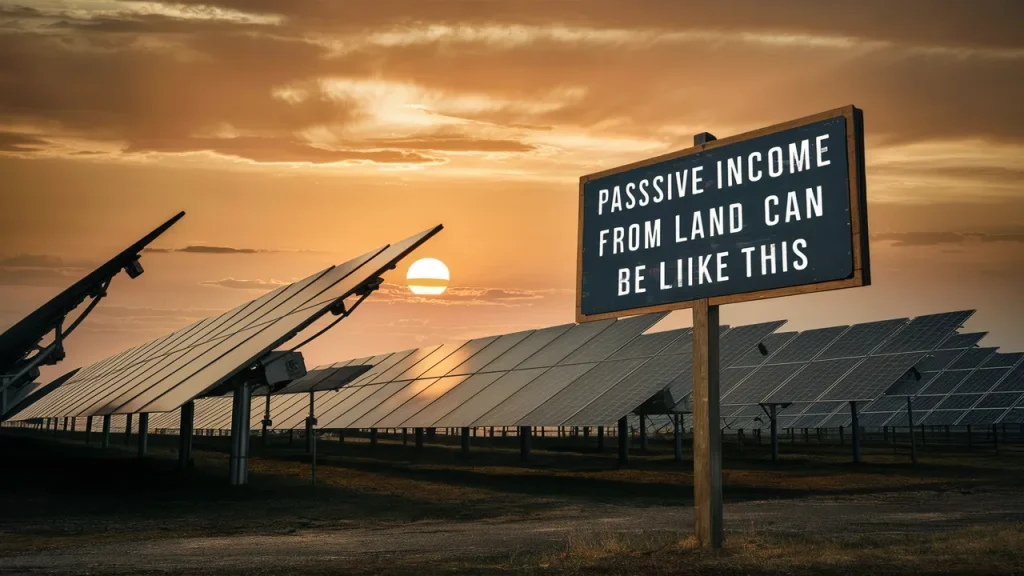
As the world moves towards renewable energy sources, the demand for solar farms has increased, presenting a lucrative opportunity for landowners.
Leasing land to solar power companies can be a highly beneficial and environmentally friendly way to generate passive income from underutilised land.
It provides a reliable source of income without the need to oversee solar farms and infrastructure. By supporting the expansion of renewable energy, you help ensure environmental sustainability.
Additionally, the value of your property may rise as it becomes a key component of the clean energy sector, which is projected to expand by USD 305.85 billion by 2030.
How Can You Lease Land To Solar Power Companies?
- Assessment of Land Suitability: The first step is to evaluate whether your land meets the basic requirements for a solar farm. This includes size, sun exposure, topography, and proximity to electrical grid connections.
- Engage with Solar Developers: After verifying suitability, contact solar developers or use platforms that connect landowners with renewable energy companies. This step can involve marketing your land to potential developers through various channels.
- Understand the Financial Terms: Leasing your land for solar involves receiving annual lease payments. The rates can vary depending on several factors, including the location, land size, and lease agreement terms. Negotiating terms that will ensure a steady, long-term income is essential.
- Legal and Regulatory Compliance: Engaging legal help to review and negotiate the terms of the lease agreement is highly recommended. This step ensures that all legal, environmental, and regulatory aspects are adequately covered, protecting your interests and ensuring compliance with local laws.
- Development and Operations: The solar developer will handle the design, permitting, construction, and operation of the solar energy system. As a landowner, your involvement in the day-to-day management of the solar farm is minimal as the developer takes on these responsibilities.
By following these steps, you can effectively lease your land to a solar power company, contributing to renewable energy development while earning passive income.
How Much Can You Earn From Leasing Land To Solar Power Companies?
Potential earnings when leasing land to solar power companies can vary depending on several factors. Usually, landowners receive annual rental payments ranging from $300 to $5,000 per acre per year, depending on factors like the size of the property, topography, water presence, project size, location, grid access, solar irradiance, and market demand.
These lease payments are usually made annually on a per-acre basis and can increase gradually each year to keep up with inflation.
Passive Income By Letting Trees Grow

The U.S. forest products sector is a major contributor to the economy, adding $169 billion, or 5% of the manufacturing GDP.
This highlights the significant potential of using your land to grow trees.
By planting trees on your land, you can observe their development into valuable timber.
This strategic, long-term investment can result in a valuable timber harvest, boosting both your revenue potential and tax benefits.
How To Grow Trees?
1. Selection of Land:
- Choose land suitable for tree cultivation, considering soil quality, climate, and topography.
- Assess the land’s current tree population, if any, to determine the potential for growth or the need for planting new trees.
2. Research and Planning:
- Identify tree species that thrive in your area and have a high market value.
- Develop a forest management plan, potentially with the help of a professional forester, to set goals and determine which trees to plant or manage.
3. Planting Trees:
- Purchase high-quality seedlings or seeds. Opt for disease-resistant varieties where possible.
- Plant at the right time of year, which is usually during the dormant season from late fall to early spring.
4. Ongoing Maintenance:
- Protect young trees from pests, competing vegetation, and damage caused by animals.
- Thin the trees periodically to reduce competition for resources and to improve growth rates and tree health.
5. Monitor and Protect:
- Regularly inspect your trees for signs of disease or pest infestations and address any issues promptly.
- Implement fire prevention strategies and consider insurance to protect against natural disasters.
6. Sustainable Harvesting:
- Depending on your management plan, decide on a harvesting strategy, such as clear-cutting or selective harvesting.
- Harvest trees at the optimal time to maximise growth and financial returns while ensuring sustainability.
7. Market and Sell:
- Stay informed about the timber market to sell your wood at the best prices.
- Consider different markets and products such as lumber, pulp, or speciality wood products.
How Much Can You Earn By Letting Trees Grow?
The potential earnings from growing trees can vary widely depending on the type of trees you decide to cultivate and your operational strategy. You might earn as much as $125,000 per acre growing certain types of trees.
However, this figure can vary significantly, indicating that there are various ways to generate a more modest passive income through tree cultivation.
For example, growing Christmas trees can be quite profitable; with the average price for a Christmas tree in 2018 standing at $78, an acre planted with trees spaced 6×6 apart could yield around $93,000 after a minimum of six years.
Money From An Airplane Hangar

If you have land near a local airstrip or in proximity to a larger airport, leasing space for an aeroplane hangar can be a lucrative passive income stream.
Although specialised, the aviation industry constantly demands hangar space. This need is driven primarily by protecting valuable aircraft from harsh weather conditions, the necessity for routine maintenance, and the storage of essential aviation equipment.
By offering a custom steel hangar, you can provide aircraft owners—whether they own private planes or operate small commercial fleets—with a secure and protective environment to house their investments.
This venture requires an initial investment in preparing and developing the land to accommodate hangars or aviation-related facilities but can lead to consistent rental income with relatively low ongoing operational demands.
How To Set Up Your Aeroplane Hangar?
- Market Analysis: Research demand for hangar space in your area and assess the competition.
- Location and Zoning: Ensure your land is near an airport and zoned for aviation use.
- Design and Planning: Decide on your services and amenities and plan the size and layout accordingly.
- Regulatory Approvals: Obtain necessary building permits and ensure compliance with aviation regulations.
- Construction: Hire experienced contractors familiar with aviation structures.
- Infrastructure and Utilities: Provide easy access and necessary utilities.
- Leasing and Management: Draft clear rental agreements and decide on a management approach.
- Insurance: Secure comprehensive insurance for the hangar.
- Marketing: Promote your hangar to potential tenants through various channels.
- Maintenance and Upkeep: Regularly inspect and maintain the hangar.
How Much Can You Earn From An Airplane Hangar?
Earnings from aeroplane hangar rentals can vary significantly based on location, size, and amenities offered. The smallest hangars can rent for between $260 to $300 a month, mid-size units for $299 to $340, and the largest for $380, with electricity billed separately.
Leasing Land to Fishermen

If your property has any water features, renting it to fishermen is an ideal way to make money.
This business model capitalises on exclusive access to your private water bodies that are stocked with fish.
Many fishermen seek out less crowded, unspoiled spots that aren’t overfished. They’re often willing to pay for the privilege of fishing in a well-stocked, serene environment. Local fishing clubs, outdoor enthusiasts, and even tourists could be part of your target market.
It gives them special places to fish while you get paid.
Your land becomes a favourite spot for fishing lovers, helping them enjoy nature.
This win-win situation supports outdoor fun and helps you reach your money goals.
How To Lease Land To Fishermen?
- Evaluate Your Property: Before you consider leasing your land, assess your property’s body of water to determine its fishing potential. Consider factors like the types of fish available, the size of the waterbody, accessibility, and whether it provides a desirable fishing experience for sportsmen and hobbyists alike.
- Understand Legal Requirements: Familiarise yourself with any legal requirements, restrictions, or permits needed to lease land for fishing activities in your area. This may include zoning laws, water rights, and environmental regulations to ensure the sustainable use of the aquatic ecosystem.
- Set Terms and Conditions: Develop a lease agreement that outlines the terms and conditions of the lease. This should include the lease duration, payment structure (such as a fixed rent or revenue share), rules and regulations for fish conservation, access rights, and maintenance responsibilities. It’s advisable to consult with a legal expert to ensure the agreement protects your interests and complies with local laws.
- Implement Liability Protections: To protect yourself against liability, have every individual entering your property for fishing activities sign a waiver or release form. This document should clearly state that fishermen are participating at their own risk and agree to hold the landowner harmless from any liability arising from their activities on the property.
- Market Your Lease: Once you have everything in place, market your land to potential lessees. This could include listing your property on fishing forums, local sporting clubs, or dedicated platforms for outdoor recreational leasing. Highlight the key attractions of your property, such as the types and abundance of fish, scenic beauty, and privacy to attract interested parties.
- Screen Potential Lessees: Conduct interviews or meetings with potential lessees to ensure they understand and agree to the terms of the lease agreement. This step is crucial for finding responsible individuals or groups who are committed to respecting your land and the fishing resources it offers.
Converting Your Land Into A Vehicle Storage Space
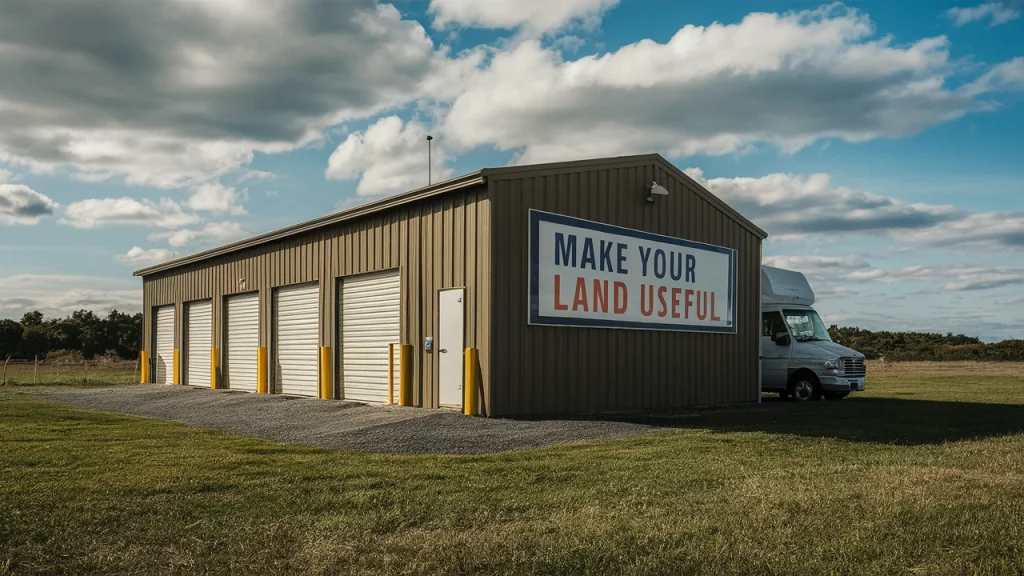
Transforming your land into vehicle storage has big benefits. It involves transforming unused or underutilised land into a facility where individuals and businesses can securely store their vehicles.
This idea taps into a growing demand for storage solutions, driven by various factors such as limited parking in urban areas, seasonal storage needs for recreational vehicles like RVs and boats, or simply the need for safe, long-term vehicle storage.
As the worldwide market for Vehicle Storage Units is expected to hit millions of dollars by 2028, you have the opportunity to enter an expanding sector.
Your property provides secure storage for vehicles, attracting owners seeking a safe space.
How To Convert Your Land Into A Vehicle Storage Space?
Leasing your land into a vehicle storage space involves a slightly different approach, where the focus is on preparing the land to be leased to a third party that will operate the vehicle storage business. This can still be a lucrative venture, minimising your day-to-day involvement yet still turning your unused land into a passive income source.
Step 1: Market Research and Legal Compliance
- Conduct Market Research: Understand the demand for vehicle storage in your area. Research the needs for RV, boat, car, and commercial vehicle storage.
- Legal Zoning and Permits: Check local zoning laws to ensure vehicle storage is allowed. Obtain necessary permits and ensure compliance with all local, state, and federal regulations.
Step 2: Prepare the Land
- Infrastructure: Focus on fundamental infrastructure such as access roads, fencing, and a secure gate. Consider the needs for electricity and water access, depending on the amenities you plan to offer.
- Layout Planning: Design a layout that maximises space usage while allowing for easy vehicle access and manoeuvrability. Include designated areas for different types of vehicles if offering segmented storage solutions.
Step 3: Set the Lease Terms
- Draft Lease Agreements: Consider consulting with a lawyer to draft a lease agreement that outlines the payment terms, responsibilities (maintenance, security, insurance), and lease duration.
- Insurance: Ensure that your lease agreement specifies the insurance requirements for both parties. You’ll need a comprehensive liability policy, and you may require the lessee to carry a policy covering their operations on your land.
Step 4: Find a Lessee
- Marketing the Property: Advertise your property through commercial real estate platforms, local businesses, vehicle storage directories, and social media.
- Networking: Connect with potential lessees such as companies already in the vehicle storage business, RV dealerships, or boat dealers that may need additional space.
Step 5: Finalise the Lease
- Negotiation and Agreement: Negotiate the lease terms with interested parties. Focus on getting terms that ensure regular, reliable income and cover any increases in your property-related expenses due to the leasing.
- Legal Review and Signing: Have a lawyer review the final lease agreement to ensure all aspects are in your favour and legally binding before both parties sign.
How Much Can You Earn By Converting Your Land Into A Vehicle Storage Space?
- A small vehicle storage facility with 10 units, located in a moderately populated area, with average monthly rental rates of $50 per unit, could generate around $6,000 per month or $72,000 per year.
- A medium-sized facility with 50 units, located in a densely populated area, with average monthly rental rates of $100 per unit, could generate around $30,000 per month or $360,000 per year.
- A large facility with 100 units, located in a high-demand area, with average monthly rental rates of $150 per unit, could generate around $60,000 per month or $720,000 per year.
Leasing Land To Grazers
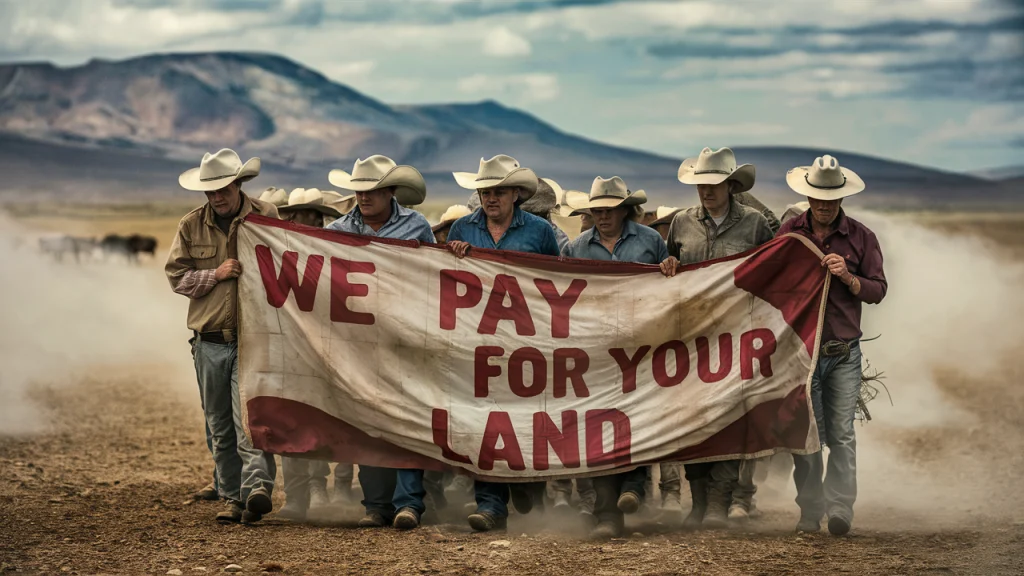
If you own land with ample open areas, consider leasing it for cattle grazing. Not only can this generate revenue, but it also assigns a practical use to your land and promotes eco-friendly land management practices.
For instance, if you’re leasing out a 100-acre pasture for grazing, you could arrange the payment in several manners: either $10 for each acre, $5 for each cattle head, or a yearly flat fee of $1,000.
This arrangement benefits the land through natural upkeep and soil fertilisation, providing you income through lease payments. It’s eco-friendly and supports local agriculture, making it a win-win.
How To Lease Land To Grazers?
When considering passive income ideas from land, leasing your property to grazers can be an effective and low-maintenance strategy. Here’s a step-by-step guide to help you start leasing your land for grazing:
1. Assess Your Land
- Evaluate Suitability: Determine if your land is suitable for grazing by assessing the quality of pasture, availability of water sources, and overall terrain.
- Land Capacity: Understand the carrying capacity of your land to ensure it can support the number of animals the lessee intends to graze without degradation.
2. Set Your Terms
- Duration: Decide on the length of the lease. Grazing leases can be short-term (seasonal) or long-term (annual or multi-year).
- Pricing Structure: Choose a pricing model. Common structures include per acre, per head of livestock, or a flat lease rate. The choice depends on what makes the most sense for the size and capability of your land.
- Responsibilities: Define who is responsible for what, including fence maintenance, water provision, and managing weed control.
3. Legal Considerations
- Draft a Lease Agreement: It’s recommended to have a written agreement that clearly outlines every aspect of the lease, including payment terms, duration, and lessee obligations.
- Get Professional Advice: Consider consulting with a lawyer or a land management expert to ensure your lease agreement covers all legal bases and protects both parties’ interests.
4. Market Your Land
- Advertising: Utilise local agricultural publications, online platforms like LandWatch, or local agricultural cooperatives to advertise your availability.
- Networking: Connect with local farming or grazing communities. Word of mouth can be a powerful tool in these circles.
5. Selecting the Right Lessee
- Vet Potential Lessees: Ensure that the grazers have a good reputation and the necessary skills to manage the cattle and your land responsibly.
- Check References: Previous landlords and fellow grazers can provide insights into a prospective lessee’s reliability and farming practices.
6. Maintain the Relationship
- Regular Check-ins: Even though leasing land for grazing offers a passive income stream, periodic checks and communications with the grazer can help ensure that the terms of the lease are being followed.
How Much Can You Earn By Leasing Land To Gazers?
The amount that can be earned by leasing land to grazers can vary widely depending on several factors, such as the location of the land, the quality of the pasture, the local market rates for leasing, and the specific terms of the lease agreement.
Leasing Land To Farmers

Research indicates that approximately 10.5% of all jobs in the United States are connected to farming, food, and related sectors, contributing 5.4% to the U.S. Gross Domestic Product (GDP). These figures highlight the steady growth of the farming industry.
Through a lease agreement and collaboration with local farmers, your land becomes a productive site for agriculture, allowing you to earn a financial return from the crops produced.
This arrangement benefits both parties: farmers gain access to necessary land without the substantial capital investment of purchasing, and you can receive a steady stream of income.
How To Lease Land To Farmers?
- Assess Your Land’s Potential: Understand what your land is best suited for – be it crop farming, livestock, organic farming, or specialty crops. Soil quality, climate, water availability, and location will dictate its use.
- Determine the Lease Type: There are several types of leases, such as crop-share, where the landowner receives a portion of the crops produced, cash rent, where a fixed fee is paid, or a flexible lease that might include components of both.
- Set Fair Terms: Determine the lease terms, including duration, rent, payment schedule, and conditions for renewal. It’s crucial to ensure the lease rate is competitive yet fair, reflecting the land’s value and prevailing market conditions.
- Draft a Legal Agreement: A well-drafted lease agreement will protect both the landowner and the farmer, outlining responsibilities, rights, and expectations clearly. This agreement should include details on land use, maintenance responsibilities, and conflict resolution methods.
- Select the Right Farmer: Vet potential tenants carefully. Look for individuals or entities with a good farming track record, solid references, and responsible agricultural practices.
- Regular Reviews and Adjustments: The agriculture sector can be affected by market fluctuations and environmental changes. Regularly reviewing and adjusting the lease terms can ensure the arrangement remains beneficial and fair.
How Much Can You Earn By Leasing Land To Farmers?
The amount you can earn by leasing land to farmers can vary greatly depending on factors such as the location, type of land, demand for agriculture, and the lease agreement specifics.
According to the USDA, Farmland brings an average annual return of 11.5%.
Rent Out Land For Event Space

It’s undeniable that with everyone feeling fatigued from being stuck indoors, concerts and festivals attract larger crowds than ever before. Picture a local musician hosting a performance on your property.
Not only do you get profit from the event organisation and from concessions sales, plus you’d have the added perk of enjoying a concert without leaving your land – and without a ticket!
The appeal of natural settings, coupled with the growing trend for personalised and outdoor gatherings, can make your property highly desirable for a wide range of events.
How To Rent Out Land For Event Space?
- Assess Your Land’s Potential: Identify which parts of your land could serve as an event space. Consider aspects like accessibility, the presence of a picturesque landscape, and suitable terrain.
- Understand Compliance and Regulations: Before proceeding, it’s crucial to check local zoning laws and obtain necessary permits. This may include allowances for public gatherings, parking, noise, and other relevant regulations.
- Develop the Venue: Depending on your starting point, this could range from basic amenities, such as installing electrical outlets and restroom facilities, to more elaborate enhancements like landscaping, lighting, and constructing pavilions or decks.
- Market Your Space: An effective marketing strategy will be essential to attract clients. Utilising social media, wedding and event planning platforms, and local networking can raise awareness of your venue.
- Offer Package Deals: Consider partnering with local vendors (caterers, decorators, event planners) to offer comprehensive package deals, making your venue more attractive and convenient for clients.
How Much Can You Earn By Renting Your Land For Event Space?
The potential earnings from renting your land for events in the US can range from hundreds to thousands of dollars per event, depending on the size, location and amenities of the space.
Rental fees for small event spaces in the US can range from around $100 per hour up to $600 per hour, depending on the size, amenities and location of the venue. Basic packages may start at $15 per person, while all-inclusive deals can reach $100 per head.
The average venue owner in the US makes 10% to 20% profit from revenue, with high-demand spaces potentially earning up to 60%. For example, if a wedding venue charges the average $11,200 rate and hosts 20 weddings per year with a 20% profit margin, you can earn $44,800 in profit annually.
Utilising Tax Incentives
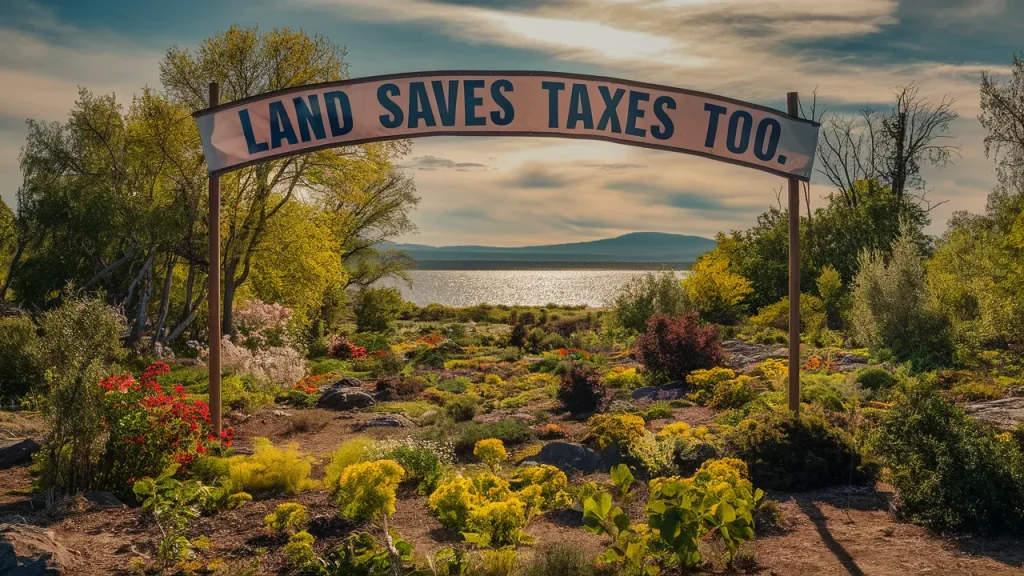
Research published in the Journal of Economic Perspectives indicates that state and local governments in the United States cumulatively spend approximately $30 billion annually on incentives for corporate taxes.
Considering this, exploring options like conservation easements or sustainable land management practices can be an effective strategy for understanding and benefiting from the tax incentive environment.
By aligning your land use strategies with activities that qualify for these incentives, you can generate income and considerably reduce your tax burdens.
How To Utilise Tax Incentives?
- Research Available Incentives: Begin by researching local, state, and federal tax incentives applicable to landowners. These might include deductions, credits, or lower tax rates for specific uses like forestry, sustainable farming, or hosting renewable energy sources (solar panels, wind turbines).
- Consult with Tax Professionals: Working with a tax advisor or an accountant who understands land-related tax incentives can provide you with insights into optimising your tax benefits while ensuring compliance with all legal requirements.
- Plan Your Land Use Accordingly: Based on the information obtained about incentives, plan how to utilise your land. For example, if you learn that there are significant tax breaks for land conservation, you might consider establishing a wetland as part of your land management strategy.
Examples Of Tax Incentives
- Conservation Easements: By granting a conservation easement, which restricts development to protect wildlife or natural resources, you might qualify for tax deductions or credits.
- Agricultural Use: Many regions offer reduced property tax rates for lands used for agriculture, potentially lowering overhead costs of farming ventures on your property.
- Renewable Energy Projects: Installing solar panels or wind turbines can qualify you for tax credits. For instance, the U.S. federal government offers a tax credit for installing solar energy systems.
How Much Can You Earn From Tax Incentives?
The potential earnings from tax incentives can vary widely depending on the nature of the investment, geographic location, industry, and specific government policies.
For example, the Inflation Reduction Act’s climate and clean energy tax incentives in the United States are designed to drive investment that could support over 1 million jobs in energy and related manufacturing sectors in the coming years, indicating significant potential financial benefits for businesses and individuals involved in these industries
Renting Land To The Beekeepers
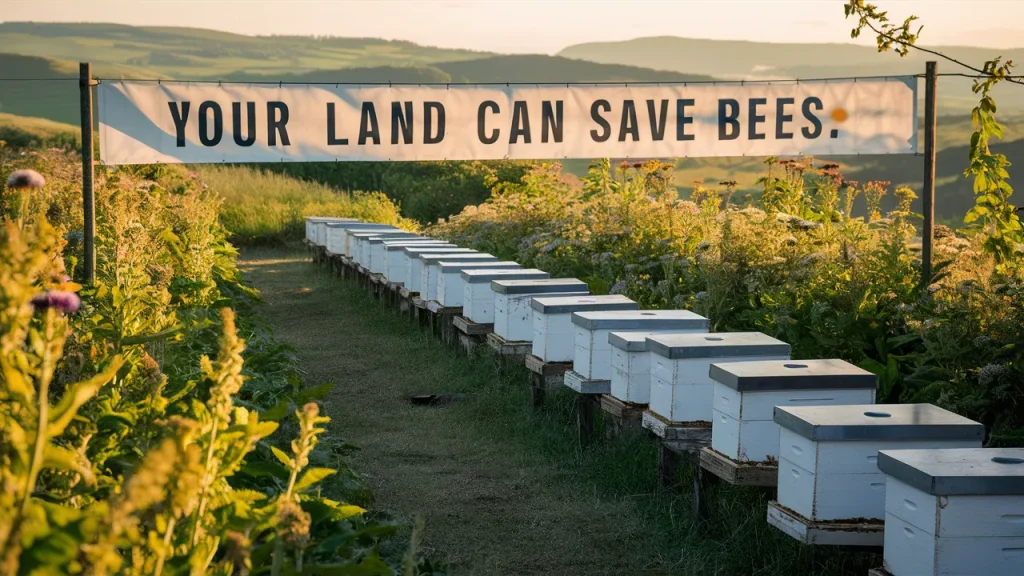
Leasing parts of your land to beekeepers supports ecological balance and provides a source of income. The Magazine of American Beekeeping reported that the honey industry has contributed $2.1 billion to the US Gross Domestic Product (GDP).
This idea allows you to contribute to preserving bee populations, which play an important role in pollinating plants and maintaining ecological balance, while also earning revenue.
How To Rent Land To The Beekeepers?
- Find Local Beekeepers: Contact local beekeeping clubs and agricultural societies, or use online platforms to connect with beekeepers looking for space to house their hives.
- Assess Land Suitability: Your land should be suitable for beekeeping, with abundant flowering plants and minimal pesticide exposure and other contaminants that could harm bees.
- Set Terms for Rental: Determine how much space you’ll rent out, the length of the lease, and other terms like access to the property and maintenance responsibilities.
- Create a Bee-Friendly Environment: Even if you’re not managing the hives yourself, maintaining a habitat that supports bee health can make your land more attractive to beekeepers.
- Market Your Land: Advertise your land’s availability as a beekeeping site on dedicated forums, agricultural websites, or social media platforms focused on sustainability and natural farming.
How Much Can You Earn From Renting Land To Beekeepers?
The potential earnings from renting land to beekeepers can vary widely and are influenced by several factors, including the location, the size and quality of the land, the demand for beekeeping in the area, and the specifics of the rental agreement between the landowner and beekeeper.
The rent can range from $10 to $50 per hive per month, with some landowners offering the space for free in exchange for honey or other benefits.
Leasing Land To Extraction Companies
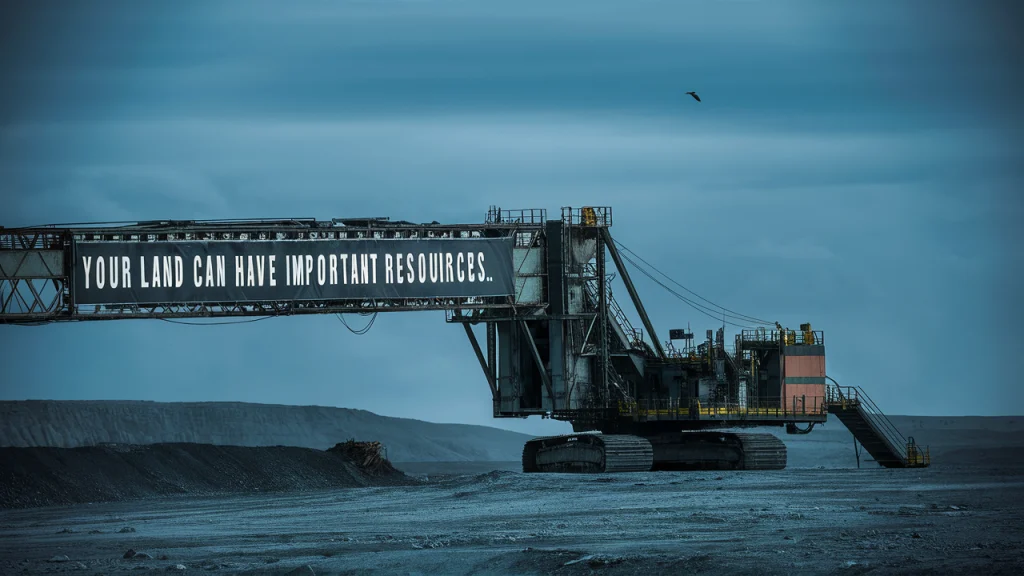
If your property has valuable resources, renting them out to extraction businesses could generate significant revenue.
This approach taps into the commercial value of natural resources such as minerals, oil, gas, or coal that may be present beneath the surface of their property.
The extractive sector, consisting of companies that extract natural resources, contributes a substantial share to the GDP of many countries. For example, in one African country, the extractive industry represents 65% of its exports and contributes 20% to its GDP.
How To Lease Your Land To Extraction Companies?
- Resource Evaluation: The first step is to enlist geologists or mineral rights experts to assess your land’s potential for valuable resources. This evaluation helps you understand what resources might be extractable and informs your decision to pursue leases.
- Finding a Partner: After identifying viable resources, the next step is negotiating with extraction companies interested in leasing your land. These companies might approach you, or you might need to market the opportunity to attract potential leaders.
- Negotiating Terms: Lease agreements detail the duration, financial compensation, extraction methods, and environmental protection. Compensation could be structured as an upfront lease bonus, royalties based on the resource’s value, or a combination thereof.
- Monitoring Compliance: Ensuring that the extraction company adheres to agreed-upon environmental protections, safety measures, and extraction limits is crucial to preventing long-term damage to your property.
How Much Can You Earn By Leasing Land To Extraction Companies?
The potential earnings from leasing your land to extraction companies can vary significantly based on the type and volume of resources extracted, market prices, and the specifics of the lease agreement.
It is common to receive both upfront payments and ongoing royalties based on the percentage of revenue generated from the extracted resources. Royalty rates for private land typically range from 12% to 25%, depending on the resource and the agreement.
Leasing Land To Carbon Offset Buyers
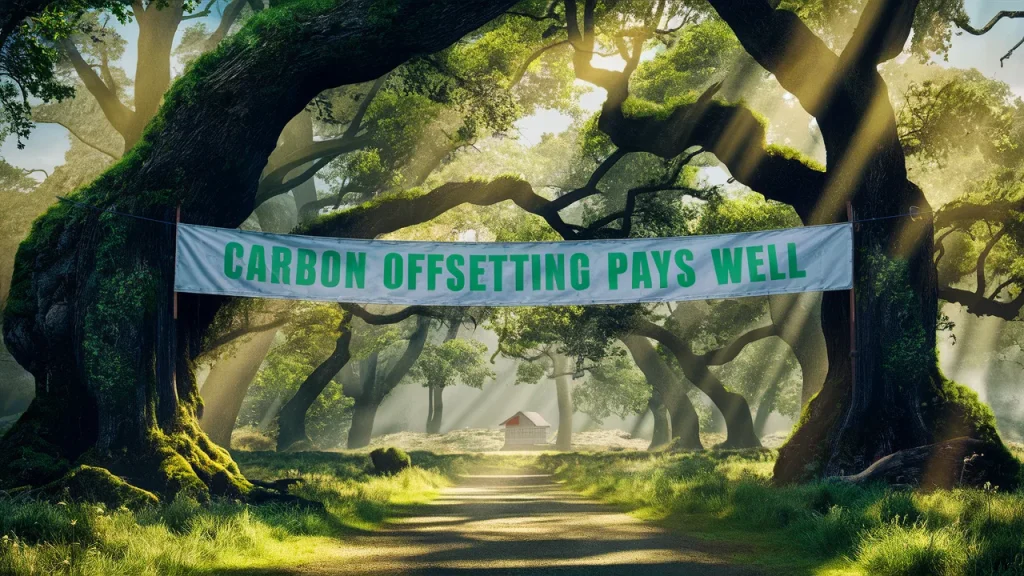
As businesses and individuals seek to counterbalance their carbon footprints, land that can be used for activities such as reforestation or establishing renewable energy sources is in high demand.
Morgan Stanley Research forecasts a significant expansion in the voluntary carbon offset market, suggesting it could reach $2 billion in 2022, $100 billion in 2030, and $250 billion by 2050.
By leasing your property for carbon offset ventures, you can play a vital role in fostering environmental sustainability. Your land will actively contribute to global climate action efforts through carbon sequestration, simultaneously providing you with an additional revenue stream.
How To Lease Land To Carbon Offset Buyers?
- Assessment of Land: Evaluate your land’s potential for carbon sequestration projects. This could involve planting trees, restoring wetlands, or converting it into a natural habitat that captures carbon dioxide.
- Certification: To participate in carbon credit markets, your land must meet certain environmental standards, and you may need to obtain certification from recognized standards bodies that quantify carbon sequestration benefits.
- Finding Buyers: Once certified, you can connect with businesses or organisations looking to invest in carbon offsets to meet their sustainability goals or regulatory requirements.
- Lease Agreement: Draft a lease agreement that details the terms, length, and compensation for using your land for carbon offset projects.
How Much Can You Earn By Leasing Land To Offset Buyers?
Leasing land for carbon offsets can provide landowners a steady stream of passive income, while also contributing to climate change mitigation. You can earn anywhere from $10 to $50 per acre per year by enrolling your land in carbon offset programs.
For example, a 1,000-acre forest project selling offsets at $10 per ton could generate $100,000 in annual revenue if each acre sequesters 1 ton of CO2.
Wordsmith. Caffeine enthusiast. A full-time business-oriented writer with a knack for turning the ordinary into extraordinary. When not working, you can find Ishan listening to music, reading or playing with doggos.
